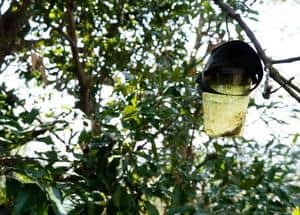Carpenter bees are one of the most common species in the United States due to their ability to survive in various weather conditions. This species builds nests in wood and often chooses wooden houses to settle in.
If you are the one suffering from carpenter bee invasion, I’ve got you covered. In this article, I focus on the “how do carpenter bee traps work?” issue, explain the peculiarities of their use, as well as how to protect your home from these nasty pests. Read on and educate yourself with my expert tips.
Guide on How to Trap Carpenter Bees
- Place a Wood Bee Catcher on the Corners/Top of Your House.
- Wait for Bees to Fly Into the Trap and Get Caught.
- Check the Jar Regularly for Trapped Bees.
- Remove Dead Insects and Release the Alive Species.
- Cover Wooden Elements With Oil-Based Paint/Varnish for Prevention.
What Is a Wood Bee Trap?
Let’s start with the danger these insects pose so that you can understand why you need such a trap. Carpenter bees are considered almost harmless to humans because they sting very rarely and are not poisonous.
People often mistake them for bumblebees due to their similar size, but they have different coloring: females’ heads are entirely black and less hairy.
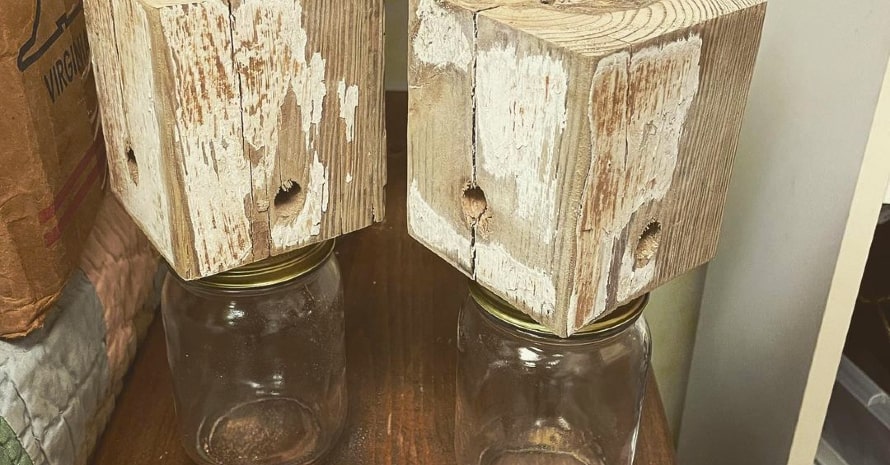
However, they can damage your house, spoil the facades, and ruin the entire construction. Carpenter bees gnaw tunnels in wood to lay their eggs, raise offspring, and spend winters there.
Damaged rafters, beams, and walls lose their sturdiness and might simply not withstand the load. You need a specialized trap to catch these insects and protect your house.
How Does a Bee Trap Work?
A wood bee trap is a small box made of softwood with holes in the lateral edges and a jar attached to the base. A bee perceives it as a potential home and flies into the hole.
Since the trap is empty inside and not suitable for laying eggs, the insect instinctively heads to the biggest source of light, the hole, to which the jar is attached. A carpenter bee gets trapped because it cannot fly straight up or crawl up smooth glass or plastic.
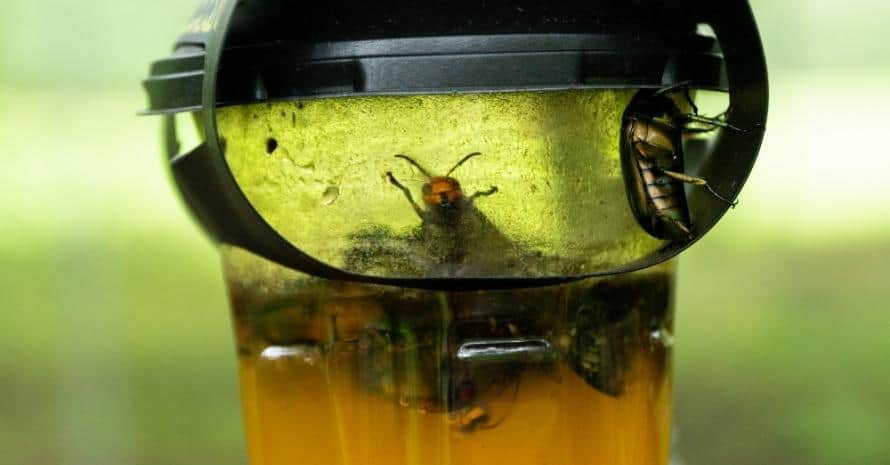
There is another type of trap with a simpler design, which is a plastic cylinder with an adhesive surface. Every insect that lands on it immediately gets caught.
If you are concerned that this trap can harm small birds, do not worry: a thin net around the sticky part will keep them away. None of these traps requires additional chemical baits.
Carpenter bees release a specific pheromone, which stands for the SOS signal. This scent works as a natural bait and attracts other bees.
Where to Place a Trap for Carpenter Bees?

You should place this trap on the corners of your house and on its top regardless of the construction type. You can roughly determine the number of traps you need based on the working radius of the trap (about 15 feet), and how many nests are located on the site.
Don’t forget to seal all the holes in the nest if your house is already damaged. If the nest is still accessible, the bees will not change their location wherever you place the trap.
Wood shavings and brownish fecal stains are the main signs that can guide you to the nest. Carpenter bees also make a distinct buzzing noise in the nest.
How to Avoid Carpenter Bees?
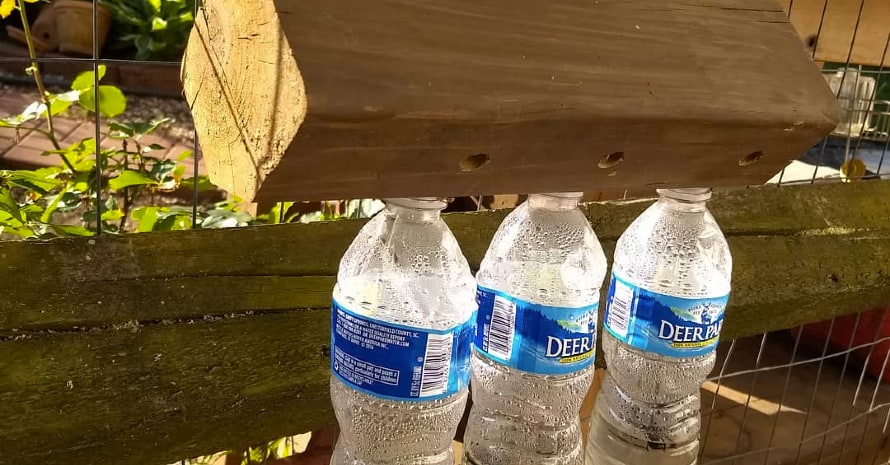
The only way to protect your wooden house from carpenter bees is to cover it with oil-based paint or varnish. Bees can harm not only wooden constructions but also fences, outdoor furniture, and many other items you can’t secure with paint, so I still advise you to pay attention to the signs I have described above.
FAQ About How a Bee Trap Works
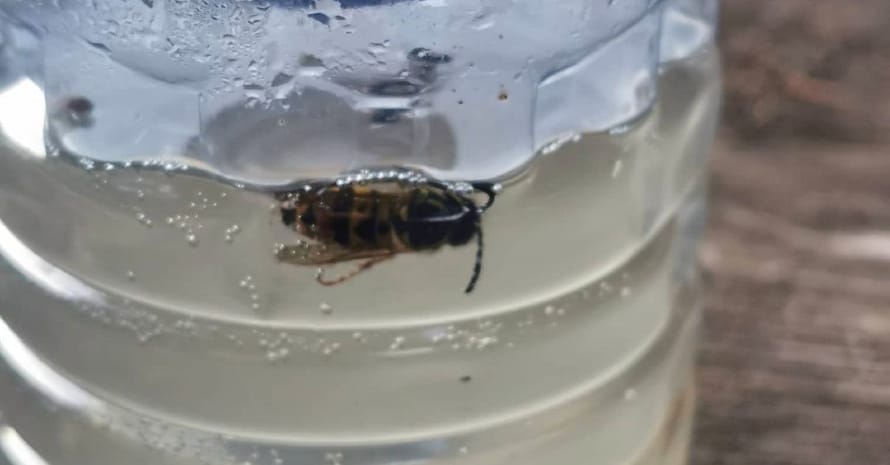
Now that you are aware of the basic principle of work of such a trap, let’s move to more practical issues. Here are the most typical questions about using carpenter bee traps: when and where to hang them, when to expect the first result, and how to get rid of bees on the first try.
How long does it take for a carpenter bee trap to work?
The first bees usually find a trap in two or three days. In case you see no changes, and the trap remains empty, you should ensure that all the nest holes are tightly sealed or move the trap to another place.
What to do with carpenter bees after you trap them?
When the jar is full, there are two ways to get rid of carpenter bees. The first one is humane: you can leave these insects alive and release them further. Be careful since they can find their way back to the nest, so make sure you free them far enough from your site.
Wash the jar thoroughly as it can smell like an “SOS-pheromone.” If you want to catch other bees using such a bait, you should place already trapped insects in the freezer for 24 hours or immerse them in water for an hour, and then put them back in a trap.
When should you put out carpenter bee traps?
Carpenter bees are most active in the spring, when they mate, lay eggs, and build their nests. Given that, you need to think about such traps with the first thaw. Any time is suitable for placing the traps, but ensure that you thoroughly seal all the holes in the nest.
Secure Your House With Wood Bee Catcher
Although carpenter bees are not dangerous to humans, they can do much harm to houses. The best way to protect your property is to carefully paint the facades and roof of your house.
However, bees still can find loopholes and even settle inside your apartment. If you find a nest inside, use a wood boring bee trap. Its effectiveness is based on the insect’s behavior; it features a simple design and does not require any extra chemical components.
Have you found a carpenter bee nest on your site, or are you just researching ways to prevent the hazard? Please, leave your thoughts in the comments.
Also read:
- Best Bee Killer Spray
- How to Get Rid of Bumble Bees
- How to Get Rid of Carpenter Bees
- How to Make a Carpenter Bee Trap
- Citrus Spray for Carpenter Bees
- Carpenter Bee Trap Bait
- How to Keep Bees Away
References
- Carpenter Bees (Richard Houseman Urban Entomology State Specialist Division of Plant Sciences)
https://extension.missouri.edu/publications/g7424 - Analysis of Honeybee Aggression (By Dylan Voeller and James Nieh) labs.biology.ucsd.edu/nieh/TeachingBee/honeybee_aggession.htm
- Carpenter Bees (by Michael F. Potter, Extension Entomologist University of Kentucky College of Agriculture)
https://entomology.ca.uky.edu/ef611 - Carpenter Bees (Ohio State University Extension)
https://ohioline.osu.edu/factsheet/hyg-2074 - Carpenter Bees (Xylocopa spp.) (By Steve Buchman The Bee Works)
https://www.fs.fed.us/wildflowers/pollinators/pollinator-of-the-month/carpenter_bees.shtml

